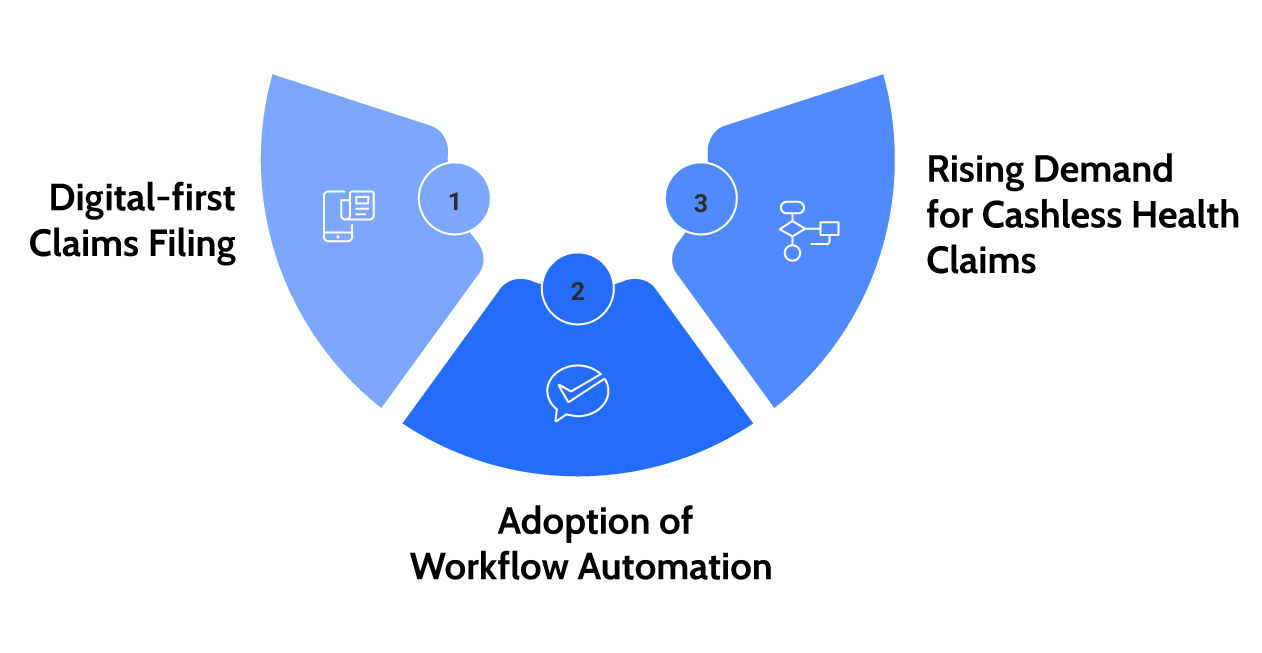In the insurance industry, managing claims smoothly is one of the most crucial aspects of the insurance value chain. Claims are where the reputations are made or lost. It is exactly the moment which defines customer trust, impacts probability, and tests operations under pressure.
Yet for many insurers, claims processing still feels like navigating through a maze which includes scattered systems, manual interventions, inconsistent validations, and longer turnaround time. Well, the result of it is that there will be customer frustration, operational fatigue and rising leakage. But what if the problem isn’t just with the team but it’s your workflow?
That’s exactly where our unified claims management system comes into play. Read on to explore more.
Top Claims Management Trends in India
The necessity for digitizing and strengthening traditional claims management processes has been widely acknowledged in the Indian insurance industry. Here, are the top trends that is fueling this necessity further:

Digital- First Claims Filing
The policyholders now expect WhatsApp based FNOL, mobile uploads of documents and real-time tracking, which ultimately leads insurers to invest in claims portals, mobile apps and self-service chatbots for reducing dependency on agents and branches
Rising Demand for Cashless Health Claims
With an increase in retail and group health policies post-pandemic, insurers are speeding up to expand cashless networks and integrating directly with hospitals and TPAs. This enables instant pre-authorizations and much faster discharge settlements.
Adoption of Workflow Automation
Both the public and private sector players are embracing claims workflow orchestration for automating repetitive tasks, enforce business rules and minimize human errors across different lines of business.
Claims Chaos and iNube Health Claims System- A Success Story
Unsatisfactory claims management can cost customers, and here is a real-life success story which went from inaccurate claims management process to an accurate claims process. One of India’s leading TPAs, who handles claims for major public sector insurers was significantly drowning in paperwork, delays and growing dissatisfaction. Their claims process relied on manual verifications and fragmented workflows which made every claim a bottleneck. But their story took a transformative spin when they partnered with us.
With our Health claims systems, which favored intelligent automation and unified workflows, the claims management seamlessly accelerated their service, restored trust and bought clarity to their claims journey when it mattered the most.
This is one of many success stories of our unified claims system which transforms the claims management process in an innovative way.
The Real Enemy of Efficiency isn’t complexity but Its Disconnection
While digitizing the claims management process is important, understanding the importance of connected process is crucial. It’s not just about the number of stakeholders in a claim which causes friction but it’s the fact that they operate in silos. Right from hospitals and insurers to TPAs to insurers and investigators, every entity will be playing a significant role but rarely from the same playbook.
The true claims efficiency comes not from cutting the people out of the loop, but from connecting them better. This requires orchestrated and intelligent workflows and not just more patchwork software.
Understanding the Gap- Slow Claims Erode Customer Trust More Rapidly
Claims management is related directly to customers and with every delayed claim, there is a significant cost of goodwill. It not only affects loss ratios but also operational budgets and brand perception. A recent study by Accenture highlights that dissatisfied customers could represent up to $170 billion in premiums at risk globally by 2027.
This raises one pivotal question for insurers- How much inefficiency can your bottom line afford to carry?
It’s Time to Understand that Claims is Not A Back-Office Burden
For most of the insurers, claims are seen as the last step in the customer journey. However, for customers it’s the moment which defines the entire relationship. What if claims become a starting point for trust, loyalty and even upsell? This is exactly where insurers can reimagine claims as a customer experience engine and not just a back-office function.


